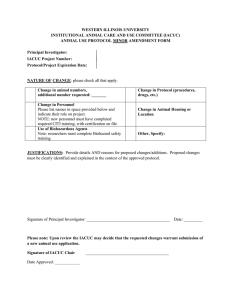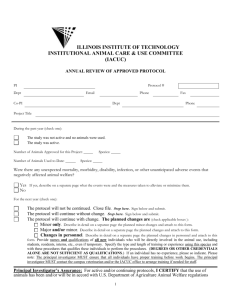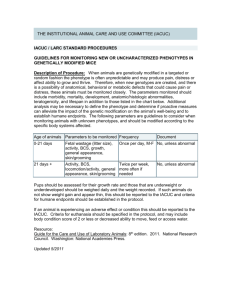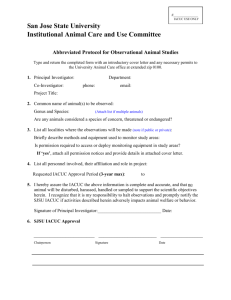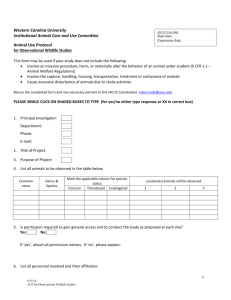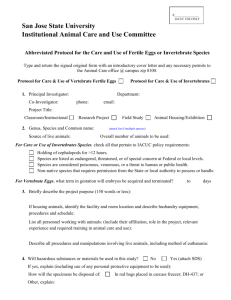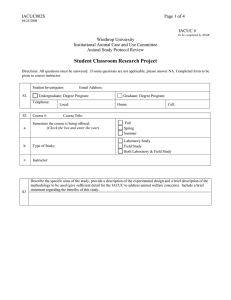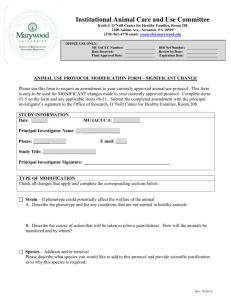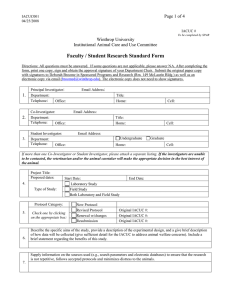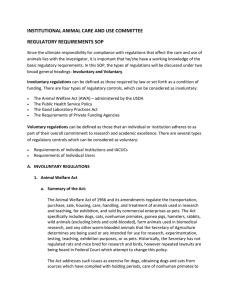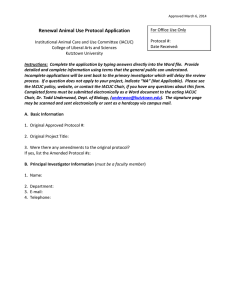This instruction sheet is designed to provide basic information and... new IACUC approved Animal Use Form. This new form is...
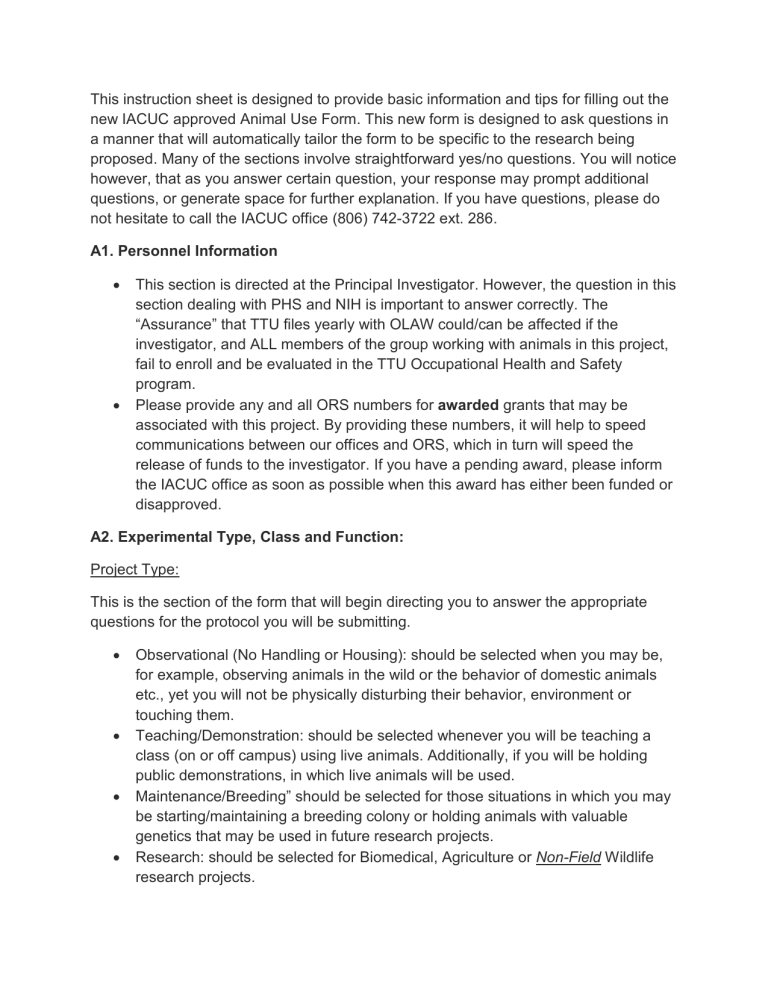
This instruction sheet is designed to provide basic information and tips for filling out the new IACUC approved Animal Use Form. This new form is designed to ask questions in a manner that will automatically tailor the form to be specific to the research being proposed. Many of the sections involve straightforward yes/no questions. You will notice however, that as you answer certain question, your response may prompt additional questions, or generate space for further explanation. If you have questions, please do not hesitate to call the IACUC office (806) 742-3722 ext. 286.
A1. Personnel Information
This section is directed at the Principal Investigator. However, the question in this section dealing with PHS and NIH is important to answer correctly. The
“Assurance” that TTU files yearly with OLAW could/can be affected if the investigator, and ALL members of the group working with animals in this project, fail to enroll and be evaluated in the TTU Occupational Health and Safety program.
Please provide any and all ORS numbers for awarded grants that may be associated with this project. By providing these numbers, it will help to speed communications between our offices and ORS, which in turn will speed the release of funds to the investigator. If you have a pending award, please inform the IACUC office as soon as possible when this award has either been funded or disapproved.
A2. Experimental Type, Class and Function:
Project Type:
This is the section of the form that will begin directing you to answer the appropriate questions for the protocol you will be submitting.
Observational (No Handling or Housing): should be selected when you may be, for example, observing animals in the wild or the behavior of domestic animals etc., yet you will not be physically disturbing their behavior, environment or touching them.
Teaching/Demonstration: should be selected whenever you will be teaching a class (on or off campus) using live animals. Additionally, if you will be holding public demonstrations, in which live animals will be used.
Maintenance/Breeding” should be selected for those situations in which you may be starting/maintaining a breeding colony or holding animals with valuable genetics that may be used in future research projects.
Research: should be selected for Biomedical, Agriculture or Non-Field Wildlife research projects.
Research with Surgery: should be selected for the above situations described but if any surgical (survival or non-survival) are planned with the project.
Project Animal Class:
This section can help to alert the Animal Care Services Department the needs for species specific training that investigators and their lab group may require. All members of the group working with live animals, by Guideance need to be proficient, in the handling and procedures required of the protocol.
A3. Lay summary
This section of the protocol should be filled out by providing the focus of the project in a manner that can be easily understood by members of the general public that are not members of, or have knowledge of scientific research. More specifically, it should be written on an “8 th grade level” for ease of communication. This is the section of the protocol that would be made available to the public should a Freedom of Information Act request be filed with the University. With that in mind, the description in this section should include general terms that would not be misunderstood or seem offensive to members of the general community.
A4. Pain & Distress:
This section/question can be confusing, but a link has been provided under ‘Categories of Pain and Distress’ to help guide you. Unless the contrary is established, you should consider that anything you do to an animal that would hurt you will hurt them. Blood collection or other minor procedures are not considered pain or distress.
A5. Overview of Experimental Design and Animal Use Timelines:
This section is designed so that you can explain in a very detailed manner the timeline and design of your project. This section is NOT, however, the place to justify species, or animal numbers, housing/caging, and so forth. The sections that follow will ask specific questions with regards to the information about those subjects. While there is a section that will address the specifics of humane and experimental endpoints, those descriptions could also be included in this section to describe the flow and potential deviations to the project objectives and timelines.
A6. SOP’s
This section has links to the current IACUC approved Standard Operating Procedures.
Many of the standard daily maintenance, husbandry and even procedures that occur
with animals have been reviewed and approved by the IACUC. By choosing to include these SOP’s in your protocol, you may be able to eliminate the need to describe them in the scientific detail section of the protocol.
B4. Duplicative Procedures
This section is designed to prompt the investigator to adequately evaluate replacement, refinement and reduction ( the 3 R’s). Obviously, any teaching, breeding or maintenance protocol would necessitate duplication, but that is not the intent of the question. The intent of this question is to elicit information, from a welfare standpoint, about procedures or research that has been previously completed. By searching and researching for similar or identical previous research, the investigator has the ability to conserve valuable research dollars and to pursue novel research for the advancement of society, and not needlessly waste research animals. However, good research is repeatable, and there is some value in confirming results from previous studies.
Therefore, checking “yes” that some duplication may occur does not necessarily diminish the value of proposed experiments, and does not automatically diminish the likelihood that the protocol will be approved.
Animal well-being & Humane Endpoints
This section has a list of commonly encountered or accepted milestones which should be regarded as humane endpoints. However, there is an area for you to describe those that may be unique to your specific project.
